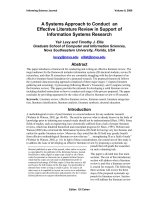Lecture A systems approach to small group interaction (8/e): Chapter 5 - Stewart L. Tubbs
Bạn đang xem bản rút gọn của tài liệu. Xem và tải ngay bản đầy đủ của tài liệu tại đây (1.02 MB, 39 trang )
CCHH AAPP TT EE RR
5
Leadership and Social
Influence Processes
Stewart L. Tubbs
McGrawHill
© 2004 The McGrawHill Companies, Inc. All rights reserved.
Slide 2
Leadership and Social Influence
Processes
•
•
•
•
•
•
•
•
•
McGrawHill
Glossary
Case Study
Status and Power
Leadership
Followership
Contingency Theory
Group Norms: Social Influence and Conformity
Group Development
The Systems Approach
© 2004 The McGrawHill Companies, Inc. All rights reserved.
Slide 3
Glossary
• Ascribed Status—the prestige that goes to a person by
virtue of his or her birth.
• Attained Status—the prestige that goes to a person on
the merits of his or her own individual accomplishments.
• Coercive Power—the power an individual has to give
or withhold punishment.
• Expert Power—our acceptance of influence from those
whose expertise we respect.
• Followership Styles—behavioral tendencies people
have toward authority figures (e.g., obedient versus
rebellious).
McGrawHill
© 2004 The McGrawHill Companies, Inc. All rights reserved.
Slide 4
Glossary
• Groupthink—refers to the tendency of group members
to share common assumptions which frequently leads to
mistakes.
• Legitimate Power—the influence we allow others,
such as our bosses, to have over us on the basis of their
positions.
• Referent Power—power based on identification with
the source of power, e.g., having admiration for someone.
• Reward Power—the power an individual has to give
or withhold rewards.
McGrawHill
© 2004 The McGrawHill Companies, Inc. All rights reserved.
Slide 5
Case Study
Department 8101
1. What mistakes do you think Rita made as a leader in
this case?
2. What, specifically, would you have done differently if
you had been Rita?
McGrawHill
© 2004 The McGrawHill Companies, Inc. All rights reserved.
Slide 6
Status and Power
• Types of Status
– Some have theorized that power and status are a
function of the ratio of the number of successful
power acts to the number of attempts to
influence.
– The success rate and relative status of any
individual will vary from group to group.
McGrawHill
© 2004 The McGrawHill Companies, Inc. All rights reserved.
Slide 7
Status and Power
• Types of Power
–
–
–
–
–
McGrawHill
Reward power
Coercive power
Legitimate power
Referent power
Expert power
© 2004 The McGrawHill Companies, Inc. All rights reserved.
Slide 8
Status and Power
• Power tends to equate to effectiveness in the
eyes of others.
– Comments in small groups tend to be directed
more often (by direction of eye contact) to
higherstatus group members than to those of
lower status.
• Positive and Negative Uses of Power
– Most experts agree that power tactics are
amoral.
McGrawHill
© 2004 The McGrawHill Companies, Inc. All rights reserved.
Slide 9
Leadership
• An effective leader is essential for optimal
group performance.
• Historic Trends
– Trait Theory
• The physical traits associated with leadership were
height, weight, physical attractiveness, and body
shape.
– Circumstances Theory
• A person may be an effective leader in one
circumstance but perform poorly in a different
circumstance.
McGrawHill
© 2004 The McGrawHill Companies, Inc. All rights reserved.
Slide 10
Leadership
• Historic Trends (continued)
– Function Theory
• Leadership consists of certain behaviors, or
functions, that groups must have performed.
– 1. Task orientation
– 2. People orientation
– 3. Changeoriented behaviors (Yolk et al, 2002, p. 18)
• Leadership Roles
– Early studies identified three different styles:
• Autocratic
• Democratic
• Laissezfaire
McGrawHill
© 2004 The McGrawHill Companies, Inc. All rights reserved.
Slide 11
Leadership
– Hypothetical Relationship Between Weight and
Leadership
McGrawHill
Source: Copyright © 1971 by Henry R. Martin. Reprinted with
© 2004 The McGrawHill Companies, Inc. All rights reserved.
permission of Meredith Corporation and Henry Martin.
Slide 12
Leadership
– Leadership Characteristics Appearing in Three
Studies
McGrawHill
Source: Reprinted with permission of JosseyBass, from James Kouzes and
© 2004 The McGrawHill Companies, Inc. All rights reserved.
Barry Posner. The Leadership Challenge, copyright © 2002 by JosseyBass.
Slide 13
Leadership
McGrawHill
Source: Adapted from Robert F. Bates. Personality and Interpersonal Behavior. Copyright © 1970 by Holt, Rinehart
& Winston, Inc. Reprinted by permission of Holt, Rinehart & Winston, Inc.
© 2004 The McGrawHill Companies, Inc. All rights reserved.
Slide 14
Leadership
– Interaction Process Analysis. Categories of
Communicative Acts
McGrawHill
Source: Based on Robert F. Bates. Interaction Process Analysis (Reading, Mass.: AddisonWesley, 1950), p. 9;
A. Paul Hare. Handbook of Small Group Research (New York: Free Press of Glencoe, 1962), p. 66; and
© 2004 The McGrawHill Companies, Inc. All rights reserved.
Slide 15
Leadership
• Leadership Styles
– Manz and Sims (2001) reported:
1. The quality of group output was better under
democratic leadership.
2. Democratic leadership took more time than
autocratic.
3. Member satisfaction was higher under democratic
leadership.
4. The democratic group had the lowest absenteeism.
5. The democratic group fostered more independence.
McGrawHill
© 2004 The McGrawHill Companies, Inc. All rights reserved.
Slide 16
Leadership—Practical Tips
Harvey Robbins and Michael Finley (1995, pp. 94
100) offer the following advice on how to be an
effective leader:
1. Project energy.
2. Be involved and involve others.
3. Assist evaluation and change for the group.
4. Persuade and persevere.
5. Look beyond the obvious.
6. Maintain perspective.
7. Utilize pyramid learning (teach others).
McGrawHill
© 2004 The McGrawHill Companies, Inc. All rights reserved.
Slide 17
Leadership—Practical Tips
Harvey Robbins . . . (continued)
8. Target energy on success opportunities.
9. Foster task linkage with others (outside the group).
10. Influence cooperative action.
11. Support creativity.
12. Take the initiative.
13. Eschew the negative.
14. Never be satisfied (seek continuous improvement).
McGrawHill
© 2004 The McGrawHill Companies, Inc. All rights reserved.
Slide 18
Leadership
• SuperLeaders
– A SuperLeader who gets a lot of other people
involved is said to develop SuperTeams.
– Manz and Neck (1999) have proposed the idea
of selfleadership:
• We are each responsible for our own choices.
• The challenge is to channel these choices in a
desirable direction.
McGrawHill
© 2004 The McGrawHill Companies, Inc. All rights reserved.
Slide 19
Leadership—Practical Tips
Henry Simms, Jr. and Charles Manz set forth the
following guidelines for the practice of self
leadership in their book The New SuperLeadership
(2001, p. 34).
– Helping others to master a selfleadership system that is
best suited to their own unique qualities is the ultimate
goal of SuperLeadership.
– Effective selfleadership combines and balances self
discipline, natural enjoyment and motivation, and
effective thinking habits and patterns.
– Learning and development of selfleadership skills have
considerable value that is worth shortterm costs.
McGrawHill
© 2004 The McGrawHill Companies, Inc. All rights reserved.
Slide 20
Leadership—Practical Tips
Henry Simms, Jr. . . . (continued)
– Facilitating the development of others’ confidence in
their selfleadership capability is an important
foundation for effective selfleadership practice.
– With patience and persistence, almost everyone can
become an effective selfleader and be of benefit to their
organizations.
– Selfleadership is a logical and effective basis for
influence in a civilized, educated world and will provide
the best outcomes over the long run.
– Selfleadership is an ethically sound basis for
organizational leadership as long as it is pursued with
the resulting benefits to the individual as a first priority.
McGrawHill
© 2004 The McGrawHill Companies, Inc. All rights reserved.
Slide 21
Followership
• Followership Styles
– Dependent
– Counterdependent
– Independent
McGrawHill
© 2004 The McGrawHill Companies, Inc. All rights reserved.
Slide 22
Followership
• Leadership and Followership Styles
McGrawHill
© 2004 The McGrawHill Companies, Inc. All rights reserved.
Slide 23
Contingency Theory
• Fiedler and Chemers (1974) and Potter and
Fiedler (1993) argue that a combination of
three separate factors determines a leader’s
effectiveness:
– Leadermember relations
– Task structure
– Position power
McGrawHill
© 2004 The McGrawHill Companies, Inc. All rights reserved.
Slide 24
Contingency Theory
• Researchers stress the following functions:
– Taskoriented behavior
– Peopleoriented, or relationship, behavior
– The readiness of followers
McGrawHill
© 2004 The McGrawHill Companies, Inc. All rights reserved.
Slide 25
Contingency Theory
• Fiedler’s Contingency Leadership Model
McGrawHill
Source: From Fiedler and Chemers. Leadership and Effective Management (Glenview, Ill: Scott, Foresman,
© 2004 The McGrawHill Companies, Inc. All rights reserved.
1974), p. 80. Copyright © 1974 by Scott, Foresman & Co. Reprinted by permission of the author.









